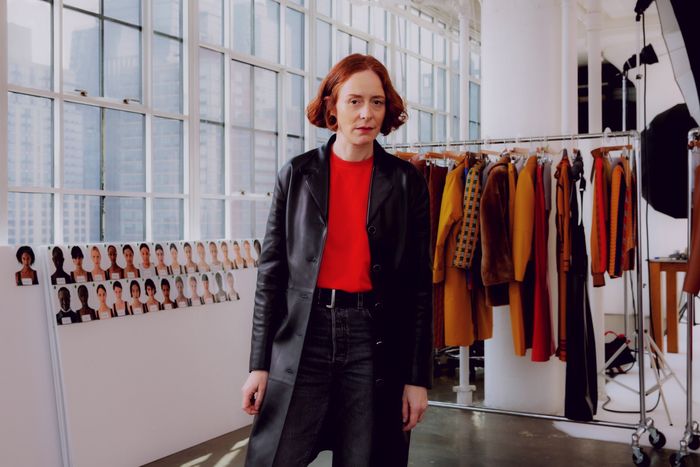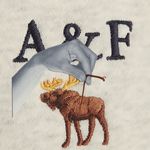
On a recent Wednesday morning, in a brightly lit photo studio in Chelsea, Nadège Vanhée is standing in front of a rack of clothing eating a croissant and catching the crumbs with an Hermès saucer perched under her chin. “My jetlag moment,” she says in a thick French accent. Behind us, the model Jill Kortleve, wearing a black duffle coat over leather leggings, stands at the end of a short runway. Stylist Jodie Barnes looks on from a nearby cluster of sofas. Vanhée strolls over to them. “Can you walk?” she asks, and Kortleve starts to strut. Less than 48 hours to showtime.
After ten years as Hermès’s artistic director of women’s ready-to-wear, Vanhée is “watching the mayonnaise coming up,” as she puts it, as years of work emulsify into critical and commercial success. Recently, she’s been described as “quietly avant-garde” and “understatedly non-conformist.” But perhaps most important, she’s managed to successfully appeal to the type of ultrawealthy Hermès shopper who’s interested in buying more from the French brand than just Birkins and silk scarves. Vanhée’s supple leather jackets and cashmere trousers have helped Hermès push through the global luxury slowdown that is dogging most of its competitors. Ready-to-wear and fashion accessories, some of which fall under her domain, are now the fastest growing parts of the business. Which is part of the reason Hermès decided to put an extra runway show on its calendar this year — the one Vanhée is preparing for when we meet. For this, the brand turned a pier warehouse into an Hermès-ified vision of downtown New York, where Leigh Lezark and Natasha Lyonne ate plates of Carbone pasta, Caroline Polachek performed on a cabaret stage in full red-leather Hermès, and Honey Dijon DJ’d a set. Still: Events like these are conceived less for the young people on the dance floor than for the VIP clients, some of whom Hermès flew in for the event, favorite Kellys in hand.
In the decade after she graduated from the Royal Academy of Fine Arts in Antwerp in 2003, Vanhée hopped from one influential designer’s studio to another. She spent a few years at Delvaux in Brussels, then she worked under Martin Margiela at his label in Paris. She believes the Belgian designer, who designed womenswear for Hermès 27 years ago, shaped her more than anyone. “We were like a football team, and he was the coach,” she says. From there she went to London to join Phoebe Philo’s team at Céline, then The Row brought her to New York; she arrived in 2011 with her then-husband, the gallerist Peter Cybulski. Of Ashley and Mary-Kate, she says, “They had a very strong idea of how they wanted to construct the brand, and I just was super-supportive of the idea of creating a very strong, tailored, timeless look.” After another three years, Hermès called; she’s been there since. Which job was the hardest to leave? “None of them.” Because the next job was so exciting? “The next thing was exciting or I had had enough,” she says, wiping her hands in a motion of dusting off the past.
If this all sounds a little safe — well, Vanhée likes to keep it that way. Though she’s been described as extraordinarily influential in, for instance, the very creation of The Row (“There really was a before and an after Nadège,” an anonymous source told this publication in 2021), she’s eager to avoid creating a cult of personality around herself. (This makes sense given the brigade of famously private designers she’s trained under and the culture of the publicly traded, but still family-owned, company she works for now.) “I don’t want people to be affected by a certain position that you can have,” Vanhée says, referring to a position she, in fact, has. “I want to be free.” She’s barely on social media; on her private Instagram, she has posted exactly zero times and has only nine followers. When I ask her about her favorite restaurants from her time in New York, she says she’d rather not endorse a place that’s still open. Instead, she says she loved Souen, the macrobiotic Soho restaurant that closed in 2019. Similarly, when I ask her to name her favorite Hermès bag, she hesitates, then points to one of the label’s most nondescript styles, the Plume. When I ask about her recent clothing purchases, she tells me about a pair of Asics.
It’s taken time to figure out the tricky balance that is the crux of her job — how to add a little of herself to the brand’s discreet products. She doesn’t want to make clothes that’ll look dated in a few years, either. “You try to really say, ‘Okay, what is my personal expression?’ You know, ‘What can I bring?’” Vanhée says. A turning point came in 2018. “There was a moment where I’m like, Oh, I really need to come back to the core of the house — the blanket coat, you know, the kind of enveloping silhouettes, the famous pyramid medor. I said good-bye to some of the more psychedelic things that I do, and I became much more quiet with colors.” (Cathy Horyn wrote that year that Vanhée had “finally found the perfect balance of classicism and fashion.”) This New York collection is a little funkier, she says. The basic idea was, in her words, “a woman who had no frontiers with her ideas, and she would go where inspiration would go.” In practice, she says, this will mean piling on the accessories and layering studded belts and chain bracelets and mariner caps over leather flight suits and body-conscious knit sets. And reintroducing a few unusual colors too — though she’s keeping it to ones found in Hermès’ archives. Many of the runway models will be dressed in black and, more specifically, black leather. She tells me she’s felt a little “emo” about hosting a show here. She loved the energy she felt living in the city. She thinks she was hired, in part, because she embodied that energy. “When I came to Hermès, I think people, especially Axel Dumas, kind of had this idea — well, there’s this idea that New Yorkers, women, are quite decisive, driven. You know, there is this vitality,” she says. Paris, she thinks, is a bit more “soporific.”
Before I leave her to her fittings, she wants to show me a leather jacket from the new collection that she’s especially pleased with — it’s camel colored, and calfskin, and will probably retail for around $10,000. One uninterrupted piece makes up the sleeves and upper back of the garment, rendering the jacket’s shoulders soft and curved. Vanhée says she wanted to re-create the shape of a saddle in the back — a reference, she says, to the brand’s origins in saddlery and harness work. I nod obligingly, but looking at the jacket on the hanger, I don’t really see what she’s describing. Because her fingers are still buttery from her croissant, she asks a colleague to lift the jacket up and put it on a nearby model. On her, the jacket comes to life, puffing up in the shoulders and sweeping down to the tailored waistline. It’s subtle, but I see the saddle. “That,” she says happily, “you’ll only see at Hermès.” The next night, that jacket, paired with bright-red knit pants and pointy boots, will head down the runway as A Tribe Called Quest’s “Luck of Lucien’’ plays. The song’s a little joke — “It’s about how French people, when they’re in New York, they think they’re cool,” she says. “It’s a bit about that.” She chooses not to elaborate further.





